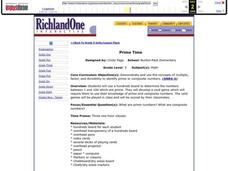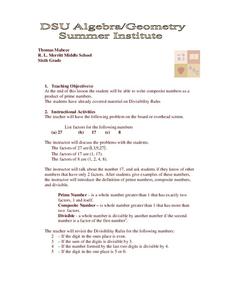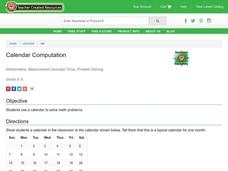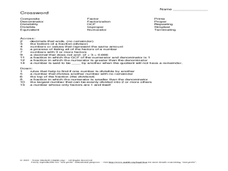Curated OER
How to Use the Rules of Divisibility and Estimation
Number patterns help your kids learn divisibility and estimation rules. This activity aims to strengthen their math fact memorization skills by presenting several rules they are expected to memorize through practice.
Curated OER
Casting Out Nines-- Divisibility By 9
In this math instructional activity, students learn the divisibility rule for 9s-- if the sum of the digits in the dividend is a multiple of 9, there will be no remainder in the quotient. Students complete 27 division problems with a 4...
Curated OER
Divisibility Rules Using Scientific Calculators
Young learners apply divisibility rules to determine if a number is a factor of another number. They discuss what numbers are factors of another number and identify patterns using divisibility rules.
Curated OER
Sieve of Eratosthenes
Students discover the Sieve of Erathosthenes. They explore a method to find all the prime numbers in a group of numbers. Using models, students practice divisibility rules while examining the difference between prime and composite numbers.
Noetic Learning
Divisibility Questions
In this divisibility activity, learners solve 4 yes/no questions. Learners decide if each three digit number is divisible by the numbers given.
Curated OER
DIVISIBILITY RULES!
Students become familiar with divisibility rules as they view a fun PowerPoint Presentation. Within this lesson, students are provided with a worksheet that explains the divisibility rules. Finally, students are given the opportunity...
Scholastic
Study Jams! Double-Digit Division
RJ had an awesome basketball season this year! Use division by double-digit numbers to calculate his scoring average in this instructional presentation. Starting with an explanation of the terms dividend, divisor, and quotient, the long...
Curated OER
Prime Time
Fifth graders complete activities related to prime and composite numbers. For this prime lesson, 5th graders make a hundreds chart with all the prime numbers. They create their own card game which deals with prime and composite numbers.
Curated OER
Smart Cookie Factors
Learners examine the concept of finding the greatest common factor. They complete number of activities as they practice identifying prime and composite numbers. Pupils apply rules of divisibility and find the greatest common factor while...
Curated OER
Early forms of Money
Students become familiar with the importance of money now and the forms of money used in the past. In this money lesson, students investigate the cour characteristics of money: portable, divisible, durable and acceptable. Students...
Curated OER
Prime Factorization: Finding Factors in the Fifth Grade
The lesson starts out with a brain drain, which is a great way to get students to activate prior knowledge and build lasting connections. They tell everything they know about prime factorization, use their knowledge to...
Curated OER
Prime Numbers and Factors
Solving factor trees is a helpful way to introduce prime numbers. Your math class practices using this method along with two-column tables to find if a number is prime or not. They also learn other vocabulary, such as composite numbers,...
Curated OER
Vocabulary Challenge
In this math vocabulary worksheet, students choose which multiple choice answer best defines twenty-five mathematical terms. Students place their answers on the lines provided.
Curated OER
Arithmetic: Fractions and Percentages
Young mathematicians review the basic operations needed for addition and subtraction of fractions. They review the rules for addition and subtraction of fractions with the same denominator, how to change them if the denominators are...
Curated OER
Number Patterns
An easy way to introduce numerical patterns, these activities can be made simpler by using addition, or more difficult with division, fractions, and percentages. Children examine patterns and determine the missing number in the sequence....
Curated OER
Prime Factors
Fifth graders review the concept of prime factorization. Then, they use the rules for divisibility and other notions to find the prime factorization of unfamiliar numbers. They solve problems in a whole class setting.
Curated OER
Calendar Computation
Students solve math problems by using a calendar. In this problem solving instructional activity, students review the days of the week and months in a year. Students complete a problem solving worksheet about the calendar.
Curated OER
Cyber Currency, Currently
Students participate in online currency activities. In this currency lesson, students complete 6 activities which include online resources. They learn about bartering, monetary systems, foreign currency, stores, selling items, and finish...
Curated OER
Number Theory and Fractions Vocabulary Crossword
In this math crossword, learners use a set of clues and 15 words about number theory and fractions to complete a crossword puzzle. A reference web site is given for additional activities.
Curated OER
Time and Timetables
In this recognizing time and timetables worksheet, learners compare Julian and Gregorian calendars, determine leap years, and apply the formula for finding the day of week and Easter day for any year. Students solve 20 problems.
Curated OER
Prime and Composite Numbers
Fifth graders investigate the concepts of composite and prime numbers. They factor different numbers and determine the number of factors for each. Based upon this information the number is declared prime or composite.
Curated OER
Least Common Multiple Practice 2
In this least common multiples practice worksheet, students examine sample problems and solve 20 problems that require them to find least common multiples.
Curated OER
Least Common Multiple Practice
In this least common multiples practice worksheet, students examine sample problems and solve 20 problems that require them to find least common multiples.
Curated OER
Least Common Multiple Practice 3
In this least common multiples practice activity, students examine sample problems and solve 20 problems that require them to find least common multiples.

























